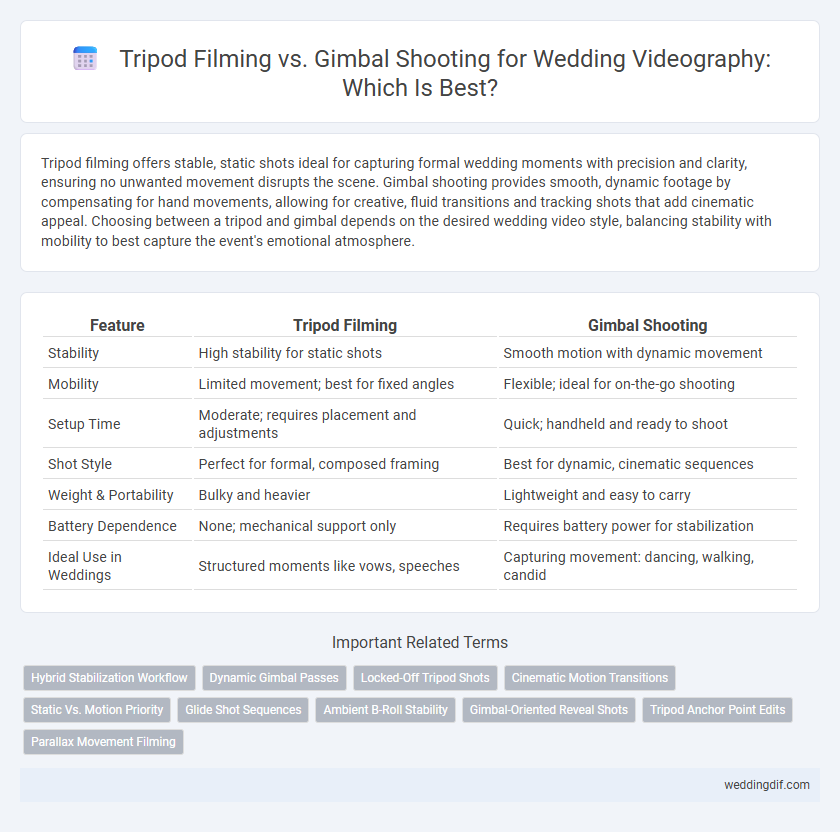Tripod filming offers stable, static shots ideal for capturing formal wedding moments with precision and clarity, ensuring no unwanted movement disrupts the scene. Gimbal shooting provides smooth, dynamic footage by compensating for hand movements, allowing for creative, fluid transitions and tracking shots that add cinematic appeal. Choosing between a tripod and gimbal depends on the desired wedding video style, balancing stability with mobility to best capture the event's emotional atmosphere.
Table of Comparison
| Feature | Tripod Filming | Gimbal Shooting |
|---|---|---|
| Stability | High stability for static shots | Smooth motion with dynamic movement |
| Mobility | Limited movement; best for fixed angles | Flexible; ideal for on-the-go shooting |
| Setup Time | Moderate; requires placement and adjustments | Quick; handheld and ready to shoot |
| Shot Style | Perfect for formal, composed framing | Best for dynamic, cinematic sequences |
| Weight & Portability | Bulky and heavier | Lightweight and easy to carry |
| Battery Dependence | None; mechanical support only | Requires battery power for stabilization |
| Ideal Use in Weddings | Structured moments like vows, speeches | Capturing movement: dancing, walking, candid |
Introduction to Wedding Videography Tools
Tripods provide stable, consistent shots essential for capturing traditional wedding moments with clarity and precision, while gimbals offer smooth, dynamic movement that enhances cinematic storytelling during active scenes. Wedding videographers often select tripods for formal sequences like vows and speeches, ensuring fixed framing and minimal shake, whereas gimbals excel in following the couple and guests through lively celebrations. Balancing both tools allows for a versatile wedding video that combines steady, professional footage with engaging, fluid motion.
Understanding Tripods in Wedding Filming
Tripods provide unmatched stability in wedding filming, essential for capturing crisp, shake-free shots during key moments such as vows and speeches. Their fixed positioning allows for consistent framing and smooth panning, ideal for creating professional and elegant footage. Tripod use ensures steady exposure and focus, crucial for maintaining high video quality in varying lighting conditions throughout the wedding ceremony.
Gimbal Stabilizers: Revolutionizing Wedding Videos
Gimbal stabilizers revolutionize wedding videos by providing smooth, cinematic shots that traditional tripod filming cannot achieve. Their advanced motorized technology offers dynamic movement and stability, capturing every emotional moment with precision. Couples benefit from versatile angles and fluid transitions, elevating the storytelling quality in wedding videography.
Pros and Cons of Tripod Videography at Weddings
Tripod videography at weddings offers superior stability, resulting in steady and professional shots, especially during static scenes such as vows or speeches. However, its lack of mobility can limit dynamic and creative angles, making it less versatile for capturing fast-paced or candid moments. Tripods also require more setup time and can be cumbersome in crowded or tight spaces, potentially restricting smooth coverage throughout the event.
Advantages and Drawbacks of Gimbal Shooting
Gimbal shooting offers smooth, dynamic camera movements that enhance wedding videos with cinematic quality, especially during moving shots and crowded environments. Its advantages include stabilization without the bulk of a tripod, increased mobility for creative angles, and ease of use in tight spaces. However, gimbals can have shorter battery life, require balancing adjustments, and may struggle with sudden jerks or fast movements compared to the static stability of tripod filming.
Visual Style: Static vs. Dynamic Wedding Footage
Tripod filming delivers stable, static wedding footage with crisp compositions ideal for capturing formal moments and structured scenes, ensuring visual clarity and professionalism. Gimbal shooting enables dynamic, fluid shots that follow movement smoothly, providing cinematic storytelling with immersive angles and natural motion ideal for lively, candid wedding moments. Balancing tripod steadiness and gimbal mobility allows videographers to create a visually engaging wedding film with both polished stills and expressive dynamic sequences.
Capturing Ceremonies: When to Use a Tripod
Tripod filming offers unparalleled stability during wedding ceremonies, ensuring steady, professional-quality shots without distraction. Ideal for capturing prolonged moments like vows and speeches, tripods maintain a consistent frame that highlights emotional expressions and key details. Using a tripod allows videographers to focus on composition and timing, delivering crisp, cinematic footage essential for preserving wedding memories.
Gimbal in Action: Perfect for Wedding Receptions
Gimbal shooting offers smooth, dynamic footage ideal for capturing the lively atmosphere of wedding receptions, allowing videographers to seamlessly navigate through crowded spaces and follow spontaneous moments. Its stabilization technology reduces shaky footage, producing professional-quality videos that reflect the celebration's energy and intimacy. Unlike tripods, gimbals provide flexibility and mobility, essential for versatile storytelling during fast-paced reception events.
Audio Considerations: Tripod vs. Gimbal Use
Tripod filming provides a stable platform, minimizing camera noise that can interfere with audio recording, making it ideal for capturing clear wedding vows and speeches. Gimbal shooting, while offering smooth, dynamic movement, may introduce mechanical sounds or handling noise that require advanced audio isolation techniques. Using external microphones and windshields enhances audio quality regardless of the chosen stabilization method in wedding videography.
Choosing the Best Stabilizer for Your Wedding Shoot
Choosing the best stabilizer for your wedding shoot hinges on the desired shot style and mobility; tripods provide unparalleled stability for static, cinematic shots and controlled framing, essential during key moments like vows and speeches. Gimbals excel in dynamic, smooth tracking shots, allowing fluid movement through the venue without camera shake, ideal for capturing dances and candid interactions. Evaluating the balance between shot stability and versatility ensures selecting the perfect tool to enhance storytelling in wedding videography.
Tripod Filming vs Gimbal Shooting for weddings Infographic

 weddingdif.com
weddingdif.com